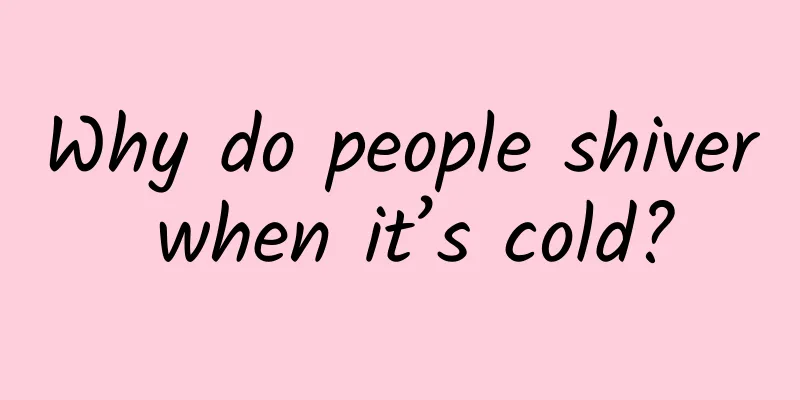Why do people shiver when it’s cold?

|
When I was a child, I heard a fable about the Cuckoo Bird. According to research, the fable of the Cuckoo Bird was adapted from the Nancun Chuogenglu by Tao Zongyi (1329-1412, a native of Huangyan, Zhejiang, a writer and historian in the late Yuan and early Ming dynasties). The original text records: There is a bird in Mount Wutai, named the Cuckoo Bird. In the hot summer, it is brilliant and beautiful, so it calls out to itself: "The phoenix is not as good as me!" In the cold winter, its feathers fall off, and it is as dull as a chick, so it calls out to itself: "Just get by." Legend has it that there is a small bird on Mount Wutai that is different from others. It has four legs and a pair of bare fleshy wings and cannot fly like other birds. People call it "Chanhao Bird". In summer, the cuckoo bird is covered with gorgeous feathers, and looks very beautiful. It also has a loud singing voice, and its call is very moving - beautiful and moving! The cuckoo bird is very proud, thinking that it is the most beautiful bird in the world, and even the phoenix cannot compare with it. So it shakes its feathers all day long, walks around, and sings proudly: "The phoenix is not as good as me! The phoenix is not as good as me!" It is "showing off" all the time ! She showed off her feathers and voice everywhere, and laughed at others who worked hard. A kind bird reminded her, "Build a nest quickly! Otherwise, how will you survive in winter?" The cuckoo bird said contemptuously, "Winter is still early, why rush! Take advantage of the good time today and have fun!" Summer passed, autumn came, and the birds were busy. Some began to fly south in groups, preparing to spend the warm winter there; some stayed and worked hard all day, accumulating food, repairing nests, and making preparations for the winter. Only the cuckoo bird had neither the ability to fly south nor the willingness to work hard, so it still wandered around all day, showing off its beautiful feathers and moving singing voice everywhere. Winter finally came. The weather was extremely cold. The birds all hid in their warm nests to keep out the cold. The beautiful feathers of the cuckoo bird fell off. At night, it hid in the cracks of the rocks, shivering with cold all over. It kept calling out, "Shiver, shiver, I will make a nest tomorrow! Shiver, shiver, I will make a nest tomorrow!" It was a constant "shiver" ! - It was so beautiful that it froze me! When the sun came out in the morning, the cuckoo felt warm again. It was so proud that it completely forgot the pain it had suffered in the cold night before. It sang happily again: "Just get by! Lying down on a sunny slope! Just get by! Lying down on a sunny slope!" The bird bathing in the sun advised her, "Hurry up and build a nest, or you will shiver with cold at night." The cuckoo said mockingly, "You don't know how to enjoy life! I want to live in the present moment." The cold night came again, and the cuckoo continued to repeat the same story as last night. After repeating this for several nights, heavy snow suddenly fell. The birds wondered why the cuckoo did not make any sound. When the sun came out, everyone looked for it and found that the cuckoo had already frozen to death. Let’s get back to the point. Why do people shiver when it’s cold? Humans are warm-blooded animals. Human body temperature is generally maintained between 36-37.5℃. When the human skin contacts the outside temperature, the perceived temperature will be directly transmitted to the control center in the medulla oblongata that controls breathing, heartbeat, body temperature, etc. When the weather is hot, the body temperature control center will control the sympathetic nerve excitement, causing the skin pores and sweat pores to open to dissipate heat and sweat to lower the body temperature. When the weather is cold, the temperature gradient on the surface of the body increases, which speeds up the heat dissipation of the skin, causing the body temperature to drop; at this time, the sympathetic nerves will stimulate the body's heat-producing organs to intensify heat production; when the cold intensifies, the sympathetic nerves will cause the muscles in various parts of the limbs, including those near the jaws, to shiver, causing the muscles and fat cells to generate heat energy due to contraction, replenishing the body with heat to maintain body temperature balance. The main parts of the human body that produce heat are the internal organs and muscles. When a person is at rest, the body temperature is maintained mainly by the basal metabolic heat production of the internal organs. The liver is the main heat-producing organ among the internal organs. Therefore, there is a saying among the people that "it's so cold that my liver is trembling!" It can be seen that it is extremely cold. In winter, people tend to have a better appetite, stronger digestive ability, and increased basal metabolic heat production. Therefore, if you are full, you will not be hungry, and if you are full, you will not be cold. Muscle activity can generate a lot of heat. During strenuous exercise, skeletal muscle heat production is 10 to 15 times greater than visceral basal metabolic heat production. When basal metabolic heat production still cannot make up for the body's heat dissipation loss, people can't help but curl up their bodies. Although this does not reduce the body's surface heat dissipation area, the contraction of body surface pores can reduce heat dissipation. When the cold is severe, muscle fibers spontaneously contract synchronously, which is shivering, commonly known as shivering. Shivering can generate a considerable amount of heat in a short period of time, and its heat production is equivalent to 5 times the basal metabolic heat production. This is why "people shiver when it's cold." Shivering is the body's instinctive reaction to resist the cold. During muscle contraction, there are exothermic reactions and endothermic reactions, but the overall effect is that exothermic reactions are greater than endothermic reactions. In the chemical reaction of muscle contraction, part of the chemical energy is directly converted into mechanical energy of muscle contraction, and most of the chemical energy is released in the form of heat energy, which increases the temperature of the muscle. For example, after running, the temperature inside the quadriceps is 1.5°C higher than the temperature inside the rectum. When the muscle contracts, the myosin cross bridge periodically binds to actin, dissociates and hydrolyzes adenosine triphosphate (ATP, the most direct energy source in the body). After the hydrolysis of ATP, adenosine diphosphate (ADP) and phosphate are generated, while 7 calories/mole of energy is released. The released energy is converted into kinetic energy and heat energy of the actin filaments. The principle of ATP causing muscle contraction is that, under the action of ATP, the potential of muscle cells changes and stimulates myosin to change its shape, thereby producing muscle contraction. Muscle contraction itself is to generate "force" (the muscle contraction force caused by cold is very large), but "heat" is also a byproduct of muscle contraction. In fact, the energy provided by the biochemical reaction from ATP to ADP cannot be 100% converted into mechanical energy by muscle cells, and most of the energy is wasted in the form of heat energy. The energy utilization rate of human skeletal muscle is between 18% and 26%, which includes the energy lost from food conversion and the energy lost from conversion to mechanical energy. Heat generated by muscle contraction is necessary for warm-blooded animals to maintain body temperature and for cold-blooded animals to increase body temperature. (ATP acts like the string in a bow and arrow to store energy) Although muscle contraction can generate heat, we cannot rely on shivering to keep out the cold for a long time. Otherwise, the fable of the cuckoo may eventually appear in the real world. The "Ice Bucket Challenge" once swept across the Pacific Ocean like a gust of wind, sweeping across the motherland from the United States, and many celebrities have experienced the taste of ice water being poured on their heads. The original intention of the activity was to raise funds to fight against a rare human disease, amyotrophic lateral sclerosis, and to help with treatment. However, it didn't take long for this activity to be ruined by "enthusiastic people". It seems that solving the scientific problem of "muscle atrophy" cannot rely on "shivering" like a gust of wind to stimulate enthusiasm; hard work, "early nesting", preparations for a rainy day, and laying a solid foundation are the right way! For more popular science articles about biomechanics around us, please follow my WeChat public account "Medical Biomechanics". Why do people shiver when it’s cold? |
<<: Why do athletes love to eat bananas during competitions?
>>: The deepest well in the world is 12,262 meters deep.
Recommend
Exchange cooperation tutorial: Things you don’t know about exchange
1. The significance of volume exchange cooperatio...
Zhao Bin, founder of Agora.io: Live streaming is the new trend, and the real-time Internet industry is growing at a massive scale
【51CTO.com original article】Competition in the te...
Think outside the box, “H5-like” can help you market promotion
HTML5, which we often call H5, is a markup langua...
A money-making project that passively acquires traffic: You can also earn 200 yuan a day by intercepting traffic and selling information from Douyin comments
It is not difficult to make money. You just need ...
Datong Flowers Mini Program Agent Price Query, Datong Flowers Mini Program Agent Price How much is it?
Why should you be an agent for WeChat Mini Progra...
Faced with the rampant porn industry, Miyazaki Hayao, who is dissatisfied with his desire, picks up his pen again
"It is better to die making animations than ...
Interesting Talk about AI: A Bottle of Wine "Assists" the Wandering of the Earth
1. Let’s start from watching “The Wandering Earth...
Apple's flaw: iPhone 6's charging efficiency is not as good as mid-range phones
As functions become increasingly complete, the ba...
APICloud launches the "100 million yuan profit sharing plan", and the API ecosystem realizes the full integration of mobile development technologies
【Quick reading, article summary】 As a leading API...
Google may disable fast charging technologies such as Qualcomm and MediaTek in future Android versions
According to a report by Android central, a well-...
Six trends in digital marketing in 2021
2020 was not easy, and 2021 will be even harder. ...
Operational analysis: Lian Coffee’s “online takeaway + social fission”!
Even the fission of coffee makes me panic. Not lo...
Where did the sunflower, which is full of treasures, come from? Its domestication history began 3,000 years ago
As an ancient snack, sunflower seeds are widely l...
Oil spill, why donate hair?
In the long history of the evolution of life on E...
Google is reportedly developing a standalone VR device that can be used without a PC
Google is developing an all-in-one virtual realit...









